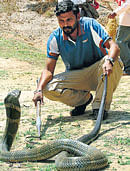
The film was shot by Kadur for the National Geographical Channel with the help of ARRS founder Romulus Whitaker. It showed how a transmission radio is placed inside two King Cobras (male and female) to know about the territory and behaviour of the world’s longest venomous snakes. This was the first time any

such type of experiment was done on the King Cobras.
“The data collected by this project will help in understanding these snakes better,” said Shankar. The two King Cobras, used for the filming, were rescued from human habitation and under the direction of the specialist, the transmission were inserted. Gowrishankar alone has rescued more than hundreds of these snakes from the human habitats in the past five years.
The film had some breath-taking scenes such as a 12-feet male king cobra 'murdering' a pregnant cobra and trying to eat it full as the female refused to court the male. “This was first time anything such as that (killing of female for refusing for mating) came to be known in the wild. In captivity, it’s common and the reason varies for that. But why it happened in the wild is unknown,” said Gowrishankar to a question asked by an audience. “More study and research in this regard can give the right results. As of now, it’s hard to say anything about that,” he added. In another sequence, the King of Snakes hunted a ratsnake. The study also revealed that male King Cobra moved more compared to its lady. In ten months, the male covered 84 kilometres of ground and came in contact with human population twice. Though these snakes are highly venomous, human death recorded by King Cobra’s bite is hardly four or five in the past decade or so.
Explaining the reasons as to why these snakes come in contact with humans, he said, “King Cobra’s favourite food is the ratsnake and ratsnakes, in turn, feed on rats which are present near human habitats.” Shankar also discussed many other myths related to these big snakes.